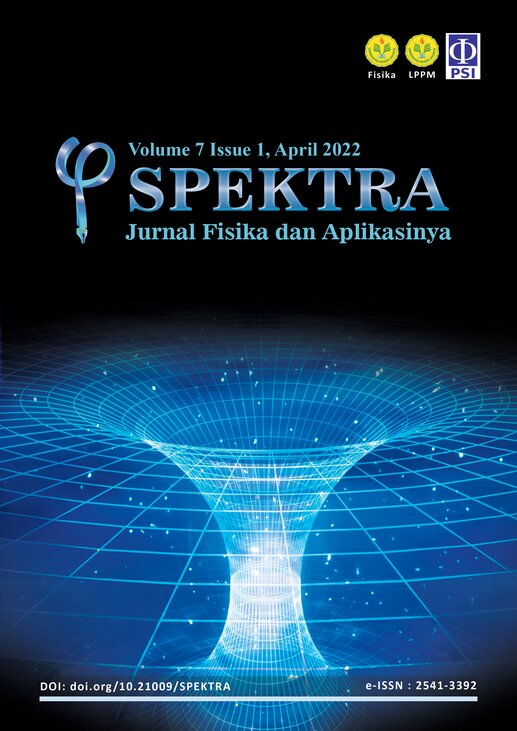IDENTIFICATION OF SOIL CORROSION POTENTIAL FOR PLANNING IN THE GAS PIPELINE CATHODIC PROTECTION SYSTEM
DOI:
https://doi.org/10.21009/SPEKTRA.071.03Keywords:
corrosion, resistivity, soil, protection, cathodicAbstract
Research has been carried out to map and identify the potential for soil corrosion for the planning of cathodic gas pipeline protection systems. The research location is located in Cimanggis - Bitung, West Java, which is located at coordinates 6o19'00 "- 6o28'00" South Latitude and 106o43'00 "- 106o 55'30" East Longitude. Measurement of soil resistivity using the Wenner method that refers to ASTM G37, with variations in the distance of 0,75m, 1,50m, 2,50m and 6,00m with the number of measuring points as many as 185 points. Based on the results of data processing and soil resistivity interpretation seen that there are several locations that have low to extreme corrosion levels. Therefore, for these locations, technical planning and calculation for the protection of the pipeline to be installed is necessary.
References
[2] C. Okoroafor, “Cathodic protection as means of saving national asse,” J. Corr. Sci. Tech, vol. 1, no. 1, pp. 1-6, 2004.
[3] ASTM G57-06, “Standard Test Method for Field Measurement of Soil Resistivity Using the Wenner Four-Electrode Method”.
[4] K. S. Lim et al., “The Relationship between Soil Resistivity and Corrosion Growth in Tropical Region,” The Journal of Science and Engineering, vol. 16, pp. 1-11, 2013.
[5] E. R. Andrew et al., “External corrosion and corrosion control of buried water mains,” American water works Association, p. 159, 2005.
[6] J. D. Rhoades, F. Chanduvi and S. Lesch, “Soil Salinity Assessment: Methods and Interpretation of Electrical Conductivity Measurements,” FAO Irrigation and Drainage, Food and Agriculture Organization of the United Nations, Rome, Paper 57, 1999.
[7] D. Michot et al., “Spatial and Temporal Monitoring of Soil Water Content with An Irrigated Corn Crop Cover Using Surface Electrical Resistivity Tomography,” Water Resources Research, vol. 39, no. 5, p. 1138, 2003.
[8] D. L. Corwin and S. M. Lesch, “Application of Soil Electrical Conductivity to Precision Agriculture: Theory, Principles, and Guidelines,” Agronomy Journal, vol. 95, no. 3, pp. 455-471, 2003.
[9] D. L. Corwin and S. M. Lesch, “Characterizing Soil Spatial Variability with Apparent Soil Electrical Conductivity: Part II,” Case Study Computer and Electronics Agriculture, vol. 46, pp. 135-152, 2005.
[10] G. N. Fedotov et al., “The Role of Organomineral Gel in the Origin of Soil Resistivity: Concept and Experiments,” Eurasian Soil Science, vol. 38, no. 5, pp. 492-500, 2005.
[11] Mbamalu, Jeremiah Emeka and F. O. Edeko, “Issues and Challenges of Aging Pipeline Coting Infrastructure in Nigeria's Oil and Gas Industry,” Corrosion, vol. 12, no. 4, pp. 45-48, 2004.
[12] A. S. Ekine dan G. O. Eemujakporue, “Investigation of Corrosion of Buried Oil Pipeline by the Electrical Geophysical Methods,” J. Appl. Sci. Environ. Manage, vol. 14, no. 1, pp. 63-65, 2010.
[13] L. Adeoti et al., “Soil Resistivity Measurement for Corrosivity Assessment using Barnes Method,” Nigerian Research Journal of Engineering and Environmental Sciences, vol. 3, no. 2, pp. 703-707, 2018.
[14] Reza Putra et al., “Pemetaan Potensi Korosi Pada Jalur Pipa Bawah Tanah Menggunakan Interpolasi Kriging,” Seminar Nasional Sains dan Teknologi, Fakultas Teknik Universitas Muhammadiyah, Jakarta, 2017.
[15] W. M. Telford et al., “Applied Geophysics,” Cambridge University Press, London. England, 1990.
[16] Fandi Ahmad, Budi Prasojo, Arie Indartono, “Pengaruh Resistivitas Tanah Terhadap Metode Proteksi Katodik SACP Dan ICCP Untuk Underground Pipeline,” Jurnal Politeknik Perkapalan Negeri Surabaya, Surabaya, Indonesia, 2018.
[17] A. S. M. Handbook, “Corrosion: Fundamentals, Testing, And Protection,” vol. 13a.
[18] NACE SP0169, “Control of External Corrosion on Underground or Submerged Metallic Piping Systems”.
Downloads
Published
How to Cite
Issue
Section
License
SPEKTRA: Jurnal Fisika dan Aplikasinya allow the author(s) to hold the copyright without restrictions and allow the author(s) to retain publishing rights without restrictions. SPEKTRA: Jurnal Fisika dan Aplikasinya CC-BY or an equivalent license as the optimal license for the publication, distribution, use, and reuse of scholarly work. In developing strategy and setting priorities, SPEKTRA: Jurnal Fisika dan Aplikasinya recognize that free access is better than priced access, libre access is better than free access, and libre under CC-BY or the equivalent is better than libre under more restrictive open licenses. We should achieve what we can when we can. We should not delay achieving free in order to achieve libre, and we should not stop with free when we can achieve libre.
 SPEKTRA: Jurnal Fisika dan Aplikasinya is licensed under a Creative Commons Attribution 4.0 International License.
SPEKTRA: Jurnal Fisika dan Aplikasinya is licensed under a Creative Commons Attribution 4.0 International License.
You are free to:
Share - copy and redistribute the material in any medium or format
Adapt - remix, transform, and build upon the material for any purpose, even commercially.
The licensor cannot revoke these freedoms as long as you follow the license terms.

 E-ISSN 2541-3392
E-ISSN 2541-3392  Focus & Scope
Focus & Scope  Editorial Team
Editorial Team  Reviewer Team
Reviewer Team  Author Guidelines
Author Guidelines  Article Template
Article Template  Author Fee
Author Fee  Publication Ethics
Publication Ethics  Plagiarism Policy
Plagiarism Policy  Open Access Policy
Open Access Policy  Peer Review Process
Peer Review Process  Retraction & Correction
Retraction & Correction  Licensing & Copyright
Licensing & Copyright  Archiving & Repository
Archiving & Repository  Contact
Contact  Mendeley
Mendeley 

